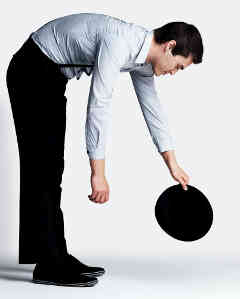Yoga, Tai Chi, Meditation

“I thoroughly recommend the Technique as being one with lifelong benefits and applications. It is a very worthwhile long term investment and a practice which I intend to continue.”
The Alexander Technique is an educational process with therapeutic effects. It doesn’t seek to replace or add anything to these excellent disciplines. Instead, it shows you how to optimise your practice and go about it without strain. This makes the activity easier and more beneficial. Teachers of these disciplines find their students make more progress.
Many adults in the West have a little difficulty at first, adapting to disciplines like Yoga, Tai Chi or Meditation. Why is this?

Bending
As very young children we tend to have very good coordination – we use our bodies as they were designed to be used, walking with an alive easy balance, bending at the hips, knees and ankles, sitting with long, strong, springy backs, and generally carrying out our activities with maximum efficiency and minimum effort. We expand our bodies to move.
By the time we are adults, our sedentary western lifestyle tends to have disrupted this good coordination. Our backs have become weaker and so sitting upright is no longer the norm – it is an effort; we slump and compress our breathing and internal organs and so feel less alive. or more agitated. Bending down tends to happen at the waist with the legs stiffened. Activities are generally carried out with excess muscular tension. This is not how we were designed to move. We now tend to contract our bodies to move and react to life – and this has become our habit.

Not the way to do it…
By adulthood we realise something is wrong – be it our back hurting, or feeling generally stiff, or feeling anxious etc. So we turn to well founded, eastern disciplines such as Yoga, Tai Chi or Meditation in attempt to improve matters.
However, this habit of compressing ourselves, of putting the brakes on our body (and mind), is unwittingly then taken into everything we do – and this includes our Yoga, Tai Chi and Meditation practice – causing us to not benefit as greatly as might be hoped or expected.
Learning and Applying the Alexander Technique
In applying the Alexander Technique to Yoga, Tai Chi or Meditation, the secret is in the preparation: the Alexander Teacher will work one-to-one with the student, with their basic coordination before they make any attempt at their particular discipline.This is done through the guiding hands of the Teacher so that the student can start to experience a different way of moving without the habitual tension that feels so ‘usual’. The student can then begin their Yoga asana, for example, whilst maintaining their basic coordination. This coordination, or lack of interference of one part with another, is the primary aim. By focussing on this process, the quality of our Yoga, Tai Chi or Meditation naturally improves.
The Alexander Technique works on universal principles of movement. Students who have studied Alexander are in a much better condition to begin and continue with Yoga, Tai Chi or Meditation. They can also look after themselves more effectively during practice to avoid excessive muscular tension that hinders progress or causes injury.
Hopefully, you will find this perspective interesting, and follow up by taking Alexander Technique lessons. The lessons may help you understand what your Tai Chi, Yoga or Meditation instructor may have been trying to tell you all along. Tai Chi, Meditation or Yoga are subtle arts, and most of us need all the help we can get in learning them.
What Yoga Teachers say
I was introduced to Alexander Technique at a yoga seminar by a colleague who teaches both disciplines and who felt that Alexander Technique would be of benefit to me. On returning home, I began regular sessions with Derek.
When I began lessons I was regularly taking strong painkillers for migraine and to ease pain in my neck and shoulders with associated ‘pins and needles’ in my arms and hands. Very quickly, things began to change and it is now increasingly rare for me to need painkillers. When I do have symptoms I can manage them by using the Technique and relaxation. I also find that AT compliments my yoga practice. My awareness in yoga postures (asana) and seated breathing practices (pranayama) is enhanced with a greater sense of ‘space’ in the body and a corresponding feeling of fluidity of movement and breath.
There are tangible benefits in other areas of my life as well. For example, after a long day of driving to and from yoga events and meetings I arrive home less tired and with more energy. Applying the Technique to my driving position has made a huge difference.
I thoroughly recommend the Technique as being one with lifelong benefits and applications. It is a very worthwhile long term investment and a practice which I intend to continue.
Chris



